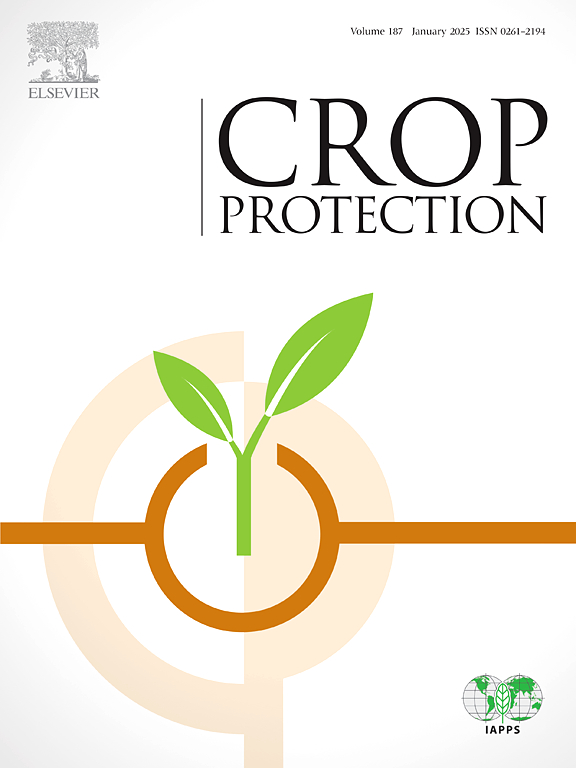Detection of Diaporthe cinerascens from latent and symptomatic fig tree cankers using species-specific primers
IF 2.5
2区 农林科学
Q1 AGRONOMY
引用次数: 0
Abstract
Fig canker is a multi-agent and complex disease, and since its identification, Diaporthe canker, primarily caused by Diaporthe cinerascens, has emerged as one of the most persistent and destructive diseases affecting fig trees in regions such as Iran, California, Canada, and Italy. The economic implications of this disease are considerable, further aggravated by the lack of effective therapeutic interventions. This study presents the development and validation of novel species-specific PCR primers designed to enhance the early and accurate detection of Diaporthe canker in artificially and naturally infected samples with mixed and latent infections. We utilized pure cultures of well-characterized D. cinerascens isolates, whose proven pathogenicity and genetic homogeneity were validated in earlier studies. Among the 82 developed primers, the TUB-Dc1 and HIS-Dc1 pairs were chosen after a thorough analysis of the β-tubulin (tub) and histone 3 (his3) genes, along with the internal transcribed spacer of rDNA (ITS) region. These selected primers successfully amplified target gene sequences in pure cultures and infected tissue samples using direct and nested PCR. The diagnostic sensitivity thresholds achieved were 100 fg μL−1 for direct PCR and 1 ag μL−1 for nested PCR. Notably, nested PCR significantly enhanced detection capabilities by up to 100,000-fold compared to direct PCR. The TUB-Dc1 primer pair effectively identified D. cinerascens in 80 % of samples with Type A canker, 22.7 % with Type C canker, and 8.8 % showing dieback symptoms. In comparison, conventional cultural methods detected the pathogen in only 30 % of Type A canker samples, and 4.4 % of Type C canker samples, with no detections in samples showing dieback. Furthermore, our results underscore the potential utility of our molecular tools for precise identification and detecting latent infections in asymptomatic samples via nested PCR. Our findings indicate that the species-specific assays are highly sensitive, specific, and reliable for detecting D. cinerascens in symptomatic and asymptomatic environmental samples. Additionally, this tool paves the way for future applications aimed at certifying pathogen-free fig saplings, an essential component for sustainable fig cultivation practices.

利用种特异性引物检测无花果树潜伏性和症状性溃疡病中的孢子虫
无花果溃疡病是一种多病原体和复杂的疾病,自发现以来,主要由无花果溃疡病引起的无花果溃疡病已成为影响伊朗、加利福尼亚、加拿大和意大利等地区无花果树的最持久和破坏性疾病之一。这种疾病的经济影响是相当大的,由于缺乏有效的治疗干预措施而进一步恶化。本研究提出了一种新的物种特异性PCR引物的开发和验证,旨在提高人工感染和自然感染的混合感染和潜伏感染样本中Diaporthe溃疡病的早期和准确检测。我们利用了具有良好特征的灰葡萄球菌分离株的纯培养物,其已证实的致病性和遗传同质性在早期研究中得到了验证。在开发的82对引物中,通过对β-微管蛋白(tub)和组蛋白3 (his3)基因以及rDNA内部转录间隔物(ITS)区域的深入分析,选择了tub - dc1和HIS-Dc1对引物。这些选择的引物成功地在纯培养物和感染组织样本中使用直接和巢式PCR扩增目标基因序列。直接PCR的诊断灵敏度阈值为100 fg μL−1,嵌套PCR的诊断灵敏度阈值为1 ag μL−1。值得注意的是,与直接PCR相比,嵌套PCR显着提高了高达10万倍的检测能力。TUB-Dc1引物对在80%的A型溃疡病样本、22.7%的C型溃疡病样本和8.8%的枯死症状样本中有效地鉴定出cinerascends。相比之下,传统的培养方法仅在30%的A型溃疡病样本中检测到病原体,在4.4%的C型溃疡病样本中检测到病原体,在出现枯死的样本中没有检测到病原体。此外,我们的研究结果强调了我们的分子工具在通过巢式PCR精确识别和检测无症状样本中的潜伏感染方面的潜在效用。我们的研究结果表明,在有症状和无症状的环境样本中,种特异性的检测方法具有高度的敏感性、特异性和可靠性。此外,该工具为未来的应用铺平了道路,旨在认证无病原体的无花果树苗,这是可持续无花果栽培实践的重要组成部分。
本文章由计算机程序翻译,如有差异,请以英文原文为准。
求助全文
约1分钟内获得全文
求助全文
来源期刊

Crop Protection
农林科学-农艺学
CiteScore
6.10
自引率
3.60%
发文量
200
审稿时长
29 days
期刊介绍:
The Editors of Crop Protection especially welcome papers describing an interdisciplinary approach showing how different control strategies can be integrated into practical pest management programs, covering high and low input agricultural systems worldwide. Crop Protection particularly emphasizes the practical aspects of control in the field and for protected crops, and includes work which may lead in the near future to more effective control. The journal does not duplicate the many existing excellent biological science journals, which deal mainly with the more fundamental aspects of plant pathology, applied zoology and weed science. Crop Protection covers all practical aspects of pest, disease and weed control, including the following topics:
-Abiotic damage-
Agronomic control methods-
Assessment of pest and disease damage-
Molecular methods for the detection and assessment of pests and diseases-
Biological control-
Biorational pesticides-
Control of animal pests of world crops-
Control of diseases of crop plants caused by microorganisms-
Control of weeds and integrated management-
Economic considerations-
Effects of plant growth regulators-
Environmental benefits of reduced pesticide use-
Environmental effects of pesticides-
Epidemiology of pests and diseases in relation to control-
GM Crops, and genetic engineering applications-
Importance and control of postharvest crop losses-
Integrated control-
Interrelationships and compatibility among different control strategies-
Invasive species as they relate to implications for crop protection-
Pesticide application methods-
Pest management-
Phytobiomes for pest and disease control-
Resistance management-
Sampling and monitoring schemes for diseases, nematodes, pests and weeds.
 求助内容:
求助内容: 应助结果提醒方式:
应助结果提醒方式:


